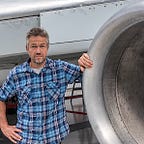Why is there a surge in birdstrikes?
Bird strikes have become a major threat to airline safety over the last decade, but as awareness grows, new solutions are being implemented. Stronger radars, habitat management and… black plastic balls.*
The movie Sully, starring Tom Hanks, not only put the spotlights on the heroics of captain Chesley Sullenberger, but also on a fairly unknown phenomenon among the general public: how powerful jet engines can be annihilated after a massive bird ingestion. Yet, a so-called “bird strike” is one of the main causes of incidents and accidents in aviation and more, the numbers are increasing.
Alone in the US, in 2015 the Federal Aviation Agency (FAA) recorded more than 14.000 bird strikes with aircraft and the FAA suggests in a November 2016 report, that contributing factors are “the increasing populations of large birds and increased air traffic by quieter, turbofan-powered aircraft.”
Sometimes these bird strikes can be lethal, thus recalls Siete Hamminga, CEO of the Dutch company Robin Radar. “In 1996 there was a fatal accident in the Dutch city of Eindhoven when a Belgian Air Force Hercules crashed after ingesting birds into two engines, killing 34 occupants.”
For the Dutch military this accident obviously did not go unnoticed and the army was eager to invest into bird strike avoidance systems. Last october, Robin Radar signed a €7 million euro deal with The Royal Netherlands Air Force to provide bird radars for all its air bases in the Netherlands. The Dutch company had previously sold its technology to other civilian aiports like Schiphol and Copenhaguen.
This means Robin Radar is becoming market leader in Europe, just like DeTect in the US. “This year, orders for 10 million dollars have come in, which is double the number of 2016,” says Robin Radar’s Hamminga.
How does it work? “The radars are fixed on the ground and can map all sort of densities in the surroundings. The they pass the information to a vehicle on the ground, which will be in charge to scare the birds with shrieks, lasers or pyrotechniques.” “But the data collected by the radar can also be used for habitat management: for instance to control certain vegetation that attract large birds or diminish garbage dumps. Eventually our high density images can be used by the aiport to pressure third parties, like neighbouring municiaplities, to control landfills and such.”
Why does bird strikes have become such a menace to aviation?
“It´s defenitely an issue of climate change,” says Hamminga “Because apparently there are more and bigger birds around. A bird of 3 kilos can already do substantial damage to an engine. An adult goose weighs more than 5 kilos. Also engines have become quieter and there are more planes flying… there is more awareness.” Hamminga is suggesting that since the so-called “miracle on the Hudson”, incidents are more easily reported.
Birds are usually attracted to airport-sites, because these are often surrounded by swaths of green and artificial ponds, used for extinguishing fires. The noise of the engines can cause flock of birds to take flight suddenly. “Most collisions between civil aircraft and birds happen under 300 feet,” says Hamminga. “So the take-off and landing are the critical phase. According to ICAO-rules, airports are responsible for keeping their airports bird-free, so some airlines put pressure on the airports to implement radar systems. And that’s where we come in,” says the Dutch CEO.
As aircraft traffic is increasing every day, other solutions for bird menaces surge: Some airports, especially in the Scandinavian countries, have found another — quite inventive — way of preventing birds from settling down around runways: plastic balls made from high density polysterene. According to Bird-X, a Chicago-based company, the deployment of floating bird balls on bodies of water “are an extremely eco-friendly way to prevent bird problems, because they completely cover the water’s surface and prevent pest birds from landing.”
Bird-X uses the eco-friendly tag, because the bird balls, that are unloaded by trucks, are a much better solution than killing the birds with traps, chemicals or poison.
One could ask whether the plastic itself is not a threat to the environment, but according to Bird-X, a company that takes pride in its environmental approach, says that “our plastic products are made from 100% recycled materials — gathered from automotive scrap, food packaging, and more. Our recycled products save tens of thousands of pounds of waste from entering landfills every year.”
This emphasis on the environmental side of the bird-strike avoidance is not a detail. Hundreds of thousands of birds are killed every year because of aviation. And that’s a cost nobody in the airline business seems to take in account. Ironically, global warming caused the surge in certain species of large birds, like the Canada geese and this global warming is partially caused because of our insatiable appetite for flying. So maybe the miracle on the Hudson was also a sign that we have to focus on cleaner transportation with less emissions of carbon dioxide.
*this story was also published on the website Aerotime.aero
